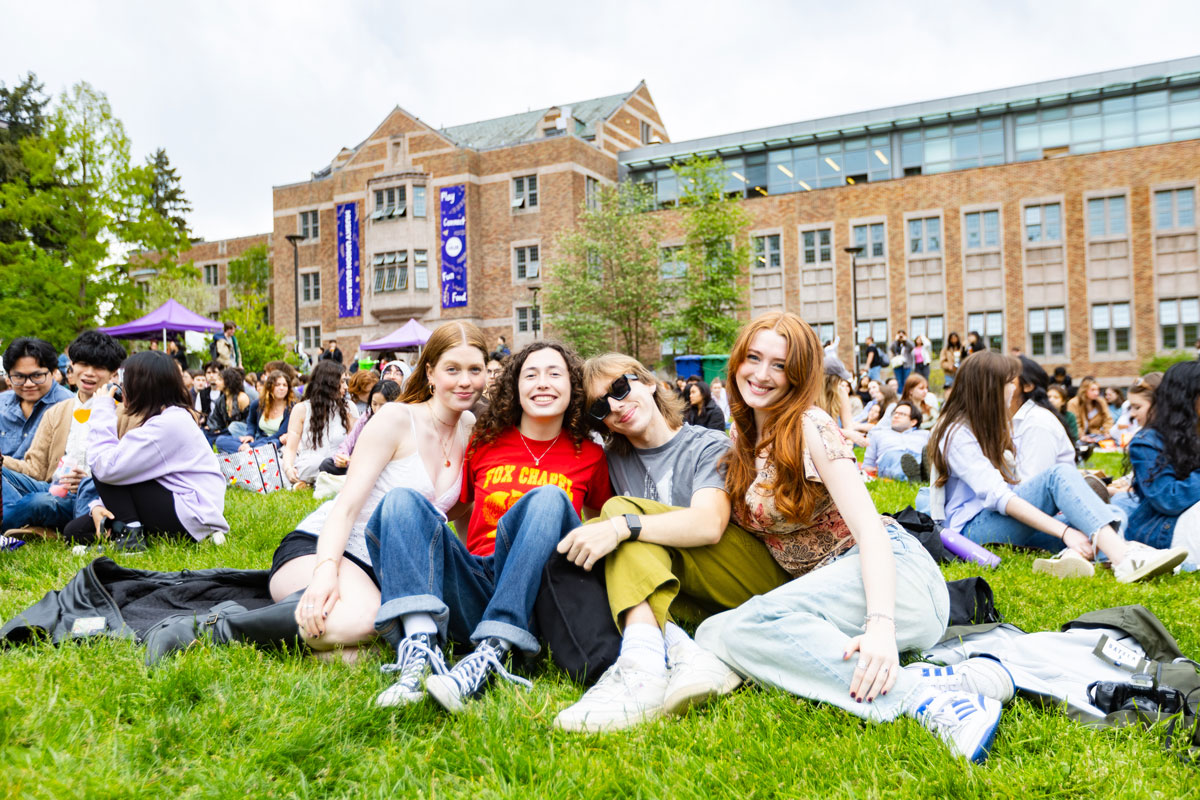
The HUB turns 75 The HUB turns 75 The HUB turns 75
Learn the history of this core campus building—and see how students have interacted with the HUB over the years.
By Shin Yu Pai | Photo by Mark Stone | September 12, 2024
The Husky Union Building has been the core of campus life since 1949. It has been the seat of student government, the host of concerts and makers fairs, a spot for student activism and the location of many a budding campus romance. Former Regent Bill Gates Sr., ’50, spent more time in the HUB than he did in the law school—in pursuit of his future wife, Mary, ’50. And Micki Flowers, ’73, still shares the details of her first date with former basketball star Bob Flowers, ’65, ’68. They went to the HUB for a jazz concert, and she tripped and fell climbing up a flight of stairs. “He picked me up and dusted me off,” she says. The rest is history.
Students in 1919 were the first to dream of a union building, but the project was delayed by the first Husky Stadium and then World War II. The plan to build “a gathering place for students” was revived in the early 1940s, according to a 70-year-old article in The Seattle Daily Times. Work began in April 1948.
On Oct. 25, 1949, student president Phil Palmer, ’54, cut a purple-and-gold ribbon held by UW President Raymond Allen and UW Alumni Association President William Ferguson, before leading a procession of students and faculty into the new $1.3 million facility. The 1949 structure had a ground-floor cafeteria, the Evergreen dining room on the first floor and lounges on the first and second floors. The barber shop (hair salon) and bowling alley came in the 1952 addition of a south wing. The first appearance of the University Bookstore came in 1962-63, the same time as the addition of the auditorium. To meet evolving student needs, the Husky Union Building has been updated and expanded over its many decades.
“The HUB has been the ‘living room’ of campus, that home away from home where students and the community can gather, play, connect and grow,” says Carrie Moore, the executive director. “Because of this rich history, the HUB isn’t just a place, it’s a feeling. The people who work at the HUB are the stewards of this amazing legacy and pour their hearts and souls into this special place, creating … that sense of belonging for everyone.”
In its first three years, the HUB doubled its space. The University Book Store moved in in 1953. A coffee shop was added in the 1960s, alongside a cafeteria, billiards room and auditorium. The 1970s saw a remodel of the food-service area and the buildout of a “shell” for the East Ballroom. In the 1980s, the HUB became home to several ASUW groups, including the Black Student Commission, American Indian Student Commission, the Asian Student Commission and La Raza (formerly MEChA). In the early 2000s, the Husky Den was remodeled into a food court and Rainy Dawg Radio debuted in the sub-basement. The UW Board of Regents approved the HUB’s most recent renovation in 2009. It took three years to complete.
“Looking back over 75 years, we feel a strong connection to the past as we look to the future,” says Moore. “As student needs and wants change, so will the HUB. We engage daily with students, staff, faculty and the community to help us shape that future, to help determine what the HUB will be for the next generation of UW students.”
Watch the HUB transform over the decades
1940s:

Construction on the HUB began in 1948 with funding and land from the UW Regents. The building opened to UW students, faculty and staff on October 25, 1949.
1950s:

In the 1950s, the term “HUB” was coined by the student newspaper, then called The Washington Daily.
1960s:

In 1962, management of the Husky Union Building transferred from the ASUW to university administration.
1970s:

A remodel began in 1975, completed in 1977, which brought the HUB to 262,000 square feet.
1980s:

The HUB became home to several ASUW groups in the 1980s, including the Black Student Commission, American Indian Student Commission, the Asian Student Commission and La Raza (formerly MEChA).
1990s:

Students play arcade games in the basement of the HUB in 1990, which was the same year the HUB lawn was redesigned. Previously, the lawn had been an unwieldy and unintentional gathering space. Removing trees and creating a flat lawn allowed for more purposeful use by students.

The ASUW Bike Shop also celebrates an anniversary in 2024: The shop opened 50 years ago in 1974 to provide affordable bike repair and maintenance guidance.
2000s:

Street fashion 20 years ago feels vaguely reminiscent of what we’d see on campus today.
2010s:

A grand remodel of the HUB began in 2010 and took three years to complete, bringing seismic improvements, new roofs and a new three-level atrium.
2024:

The HUB has hosted concerts with popular acts like Tina Turner, Thomas Dolby, Modern English and The Ramones. This year, students gathered on the HUB lawn for the Spring Show, which was headlined by AG Club.